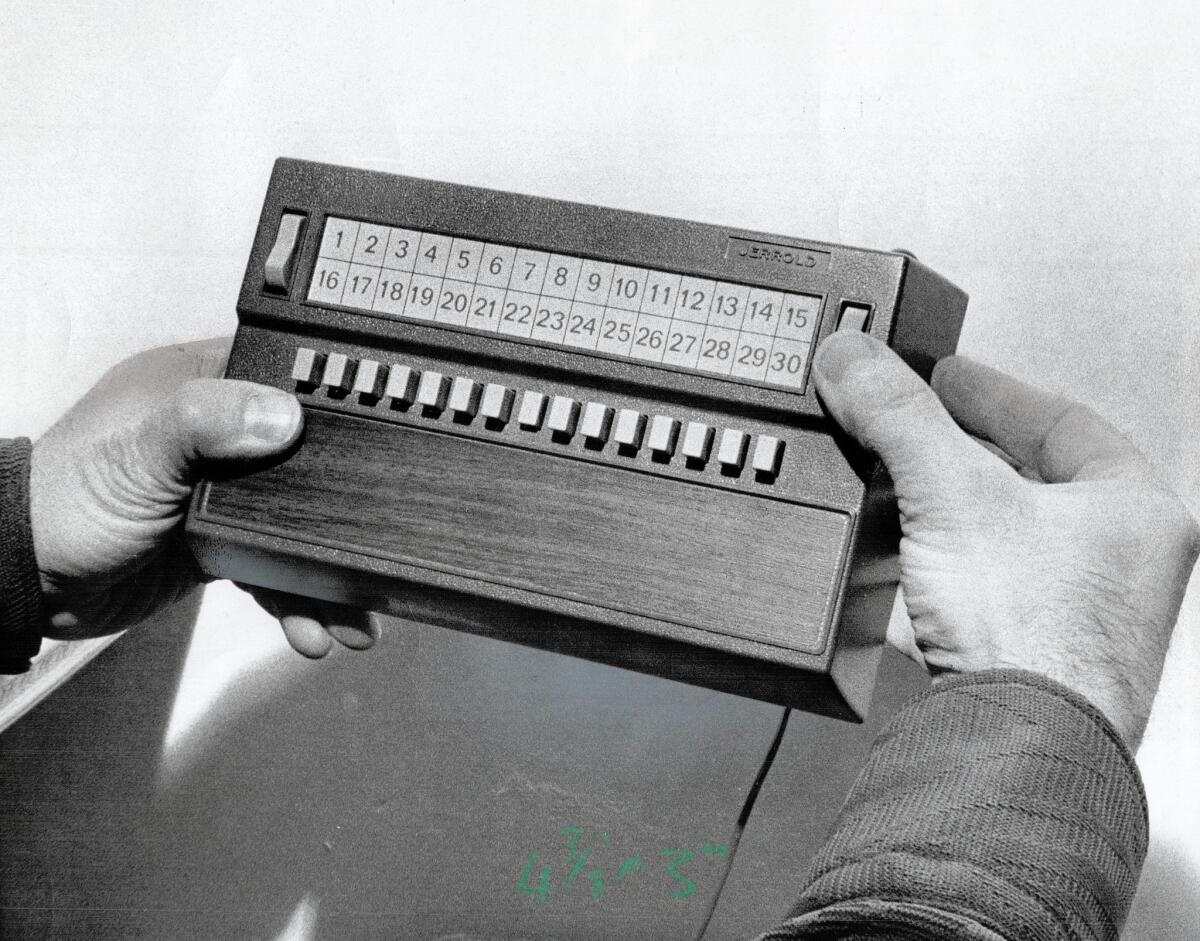Canada sets an example for a la carte pay-TV pricing

Telecom companies in Canada will have to unbundle pay-TV packages by next year and switch to a la carte channels. Above, a cable TV converter from a different era.
- Share via
Here in the Land of the Free, the telecom industry has fought aggressively for years to make sure people keep getting hundreds of pay-TV channels they don’t want, rather than just the ones they watch.
Up in the Great White North, which would be Canada, telecom companies were told by government regulators the other day that they’ll have to unbundle pay-TV packages by next year and switch to a la carte channels.
And guess what? The Canadian telecom industry is basically cool about it.
Brad Shaw, chief executive of Shaw Communications, western Canada’s largest cable company, said the new a la carte rules “will give Canadians increased choice, while providing producers, broadcasters and distributors more freedom and flexibility to innovate.”
Contrast that with the hand-wringing of U.S. telecom companies, which argue that unbundling pay-TV channels would mark the end of civilization as we know it.
“A la carte would destroy a model that produces the best TV available anywhere in the world,” says the National Cable & Telecommunications Assn., an industry trade group.
We’ve recently taken some meaningful steps toward a la carte programming in this country, but we’re nowhere close to the finish line.
Apple is preparing a pay-TV service that reportedly will feature a “skinny bundle” of 25 channels for about $30 a month. Nintendo has introduced an online TV service called PlayStation Vue. An HBO online service will debut next month.
But heavyweight cable and telecom companies refuse to part with their antiquated pay-TV business model of forcing customers to pay for channels they may not ever watch.
If we went full a la carte, the industry says, channel prices would soar and consumers would have far fewer viewing choices.
So how does Canada justify such an apocalyptic move?
Jean-Pierre Blais, head of the government’s Canadian Radio-television and Telecommunications Commission, said the decision to switch to a la carte programming “reflects what we have heard from Canadians.”
“They told us bundles offered by cable and satellite companies were large, unwieldy and expensive,” he said. “They expressed frustration that to access a particular channel, they had to pay for a station they did not want.”
Sound familiar?
By next March, Canadian broadcasters will be required to phase in by year-end an “entry-level television service” costing no more than $25 a month. It will feature local and educational channels.
Beyond the base service, Canadians will be able to create their own viewing experiences by subscribing to individual channels or small bundles of channels that, by law, must be “reasonably priced.” The system has been dubbed “pick and pay.”
Blais acknowledged that the transition to pick and pay may be challenging for some pay-TV companies.
“There may indeed be services that don’t survive, and there will be job losses,” he said. “That’s always sad. But good companies will find ways to innovate and compete and thrive if they are successful.”
Boom. There it is.
New ways of doing business will always be disorienting for industry players. Some won’t be able to adapt. But the great thing about the business world is that there’s always some entrepreneur with an innovative idea who’s ready to compete.
Blais described pick and pay as “a road map that gives all Canadians the freedom to choose the television content that meets their unique needs, budgets and realities.”
The proof, of course, will be in the pudding. We won’t really know if this is a significant win for consumers until we see what happens to monthly bills under the Canadian system.
If the U.S. telecom industry is correct, those bills will skyrocket while fewer channels will be enjoyed. I suspect, however, that most people will see their bills go down even as they continue watching their favorite channels.
Canada’s pick-and-pay approach forces channels to compete for viewers’ business. The more popular ones will be able to go it alone. The others likely will seek shelter in thematic mini-bundles — a handful of children’s channels, say, or religious channels.
Besides meeting the nation’s “reasonably priced” standard, the carriers will face additional price pressure from online services such as Netflix and Hulu, and newer players such as Sling TV and HBO Now.
I also suspect that individual channels will be priced not to gouge consumers each month but to lock in long-term business. The scrutiny of government regulators won’t hurt.
Think about the Canadian market for prescription drugs. There, too, officials require reasonable prices. As a result, Canadians pay much less for meds than Americans.
Case in point: I wrote recently about a prescription cold-sore cream that costs about $35 in Canada. In this country, it costs more than $2,500.
At $35 a tube, the manufacturer is still making a fair profit. At $2,500 a tube, the manufacturer is fleecing its customers.
U.S. telecom firms don’t like regulators telling them what to do, so they don’t hesitate to unleash the lawyers. In the meantime, consumers suffer as progress and innovation take a back seat to litigation and uncertainty.
I asked Kevin Spafford, a spokesman for Rogers Communications, one of Canada’s largest cable companies, what his firm thinks about the new a la carte rules.
“We know consumers want more flexibility and we started down this path several years ago. We already offer dozens of services a la carte and in theme packs,” he said. “This decision gives us more certainty so we can offer customers even more choice.”
Maybe that’s a Canadian way of doing things. To me, it just seems smart.
David Lazarus’ column runs Tuesdays and Fridays. He also can be seen daily on KTLA-TV Channel 5 and followed on Twitter @Davidlaz. Send your tips or feedback to [email protected].
More to Read
Inside the business of entertainment
The Wide Shot brings you news, analysis and insights on everything from streaming wars to production — and what it all means for the future.
You may occasionally receive promotional content from the Los Angeles Times.










